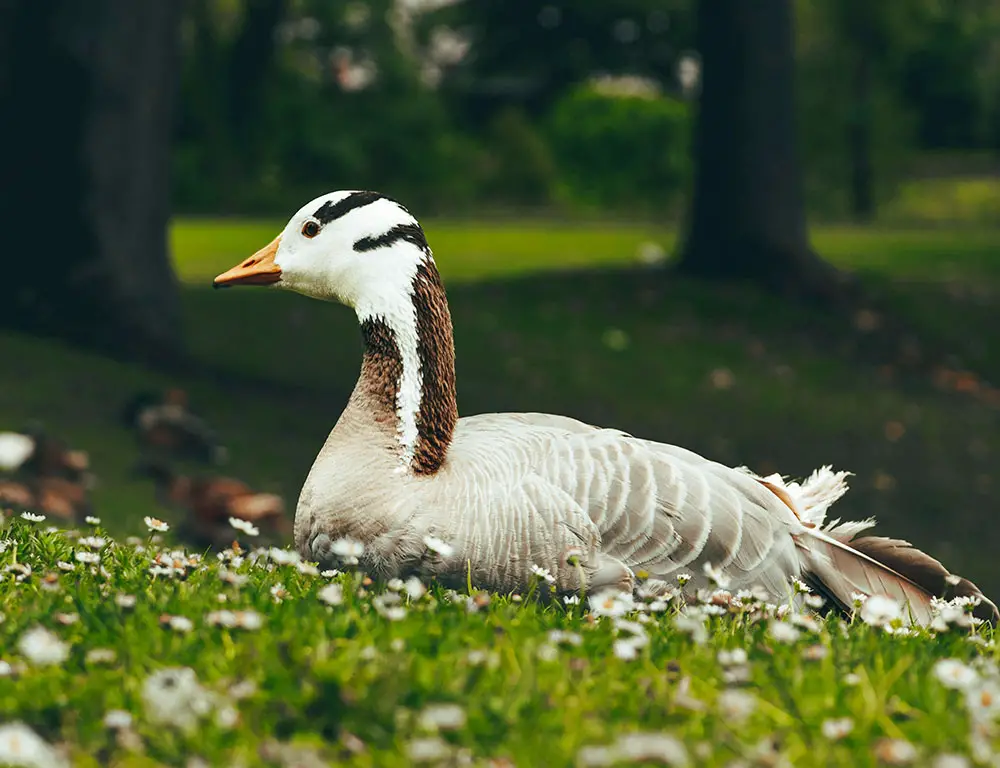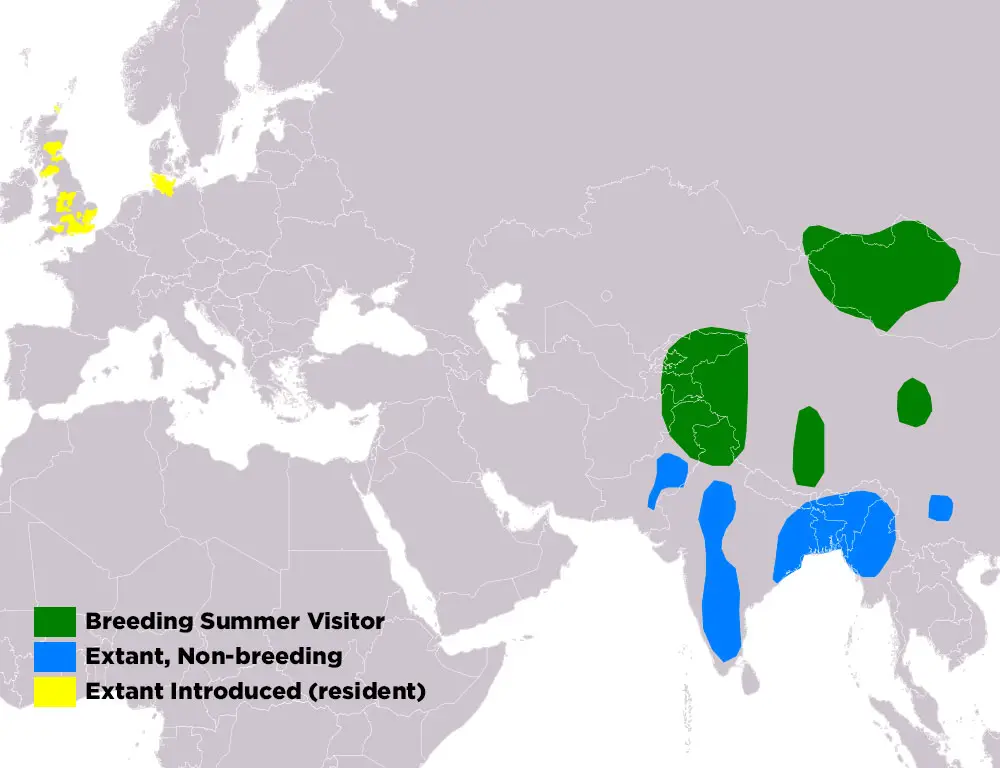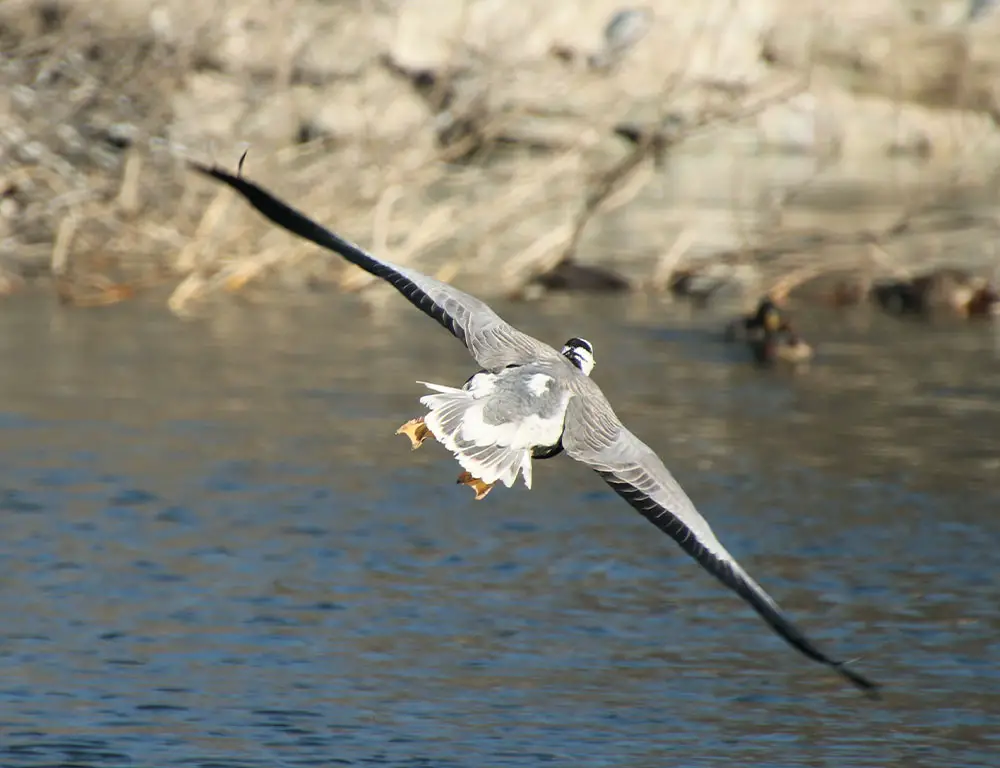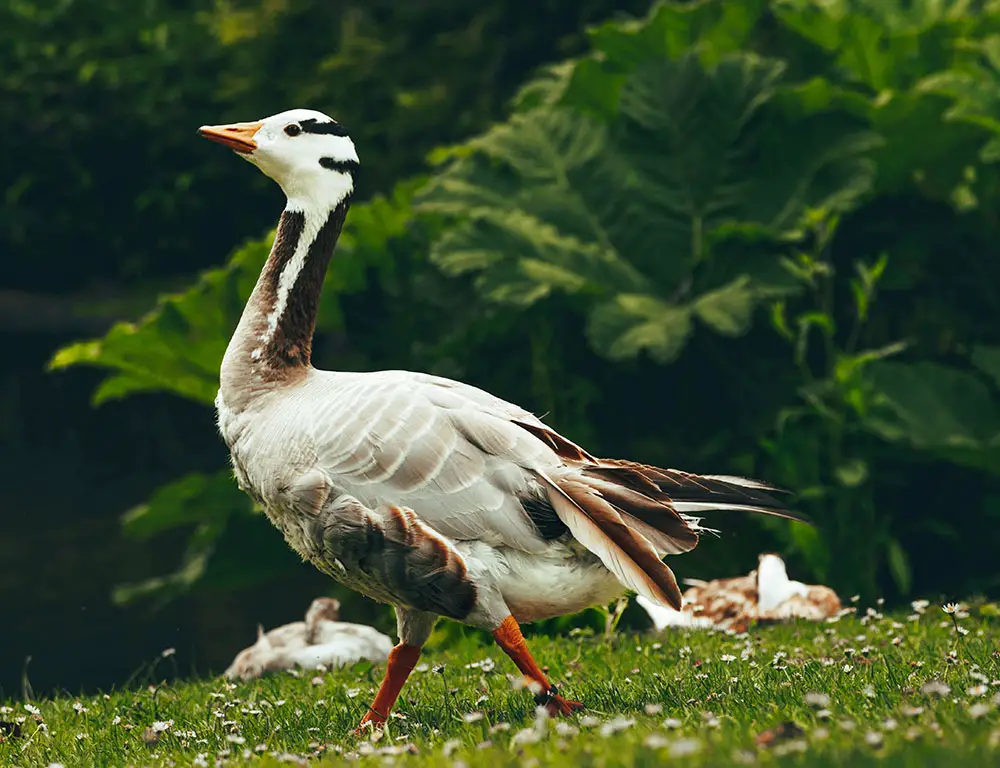The Bar-headed Goose (Anser indicus) is an extraordinary avian marvel renowned for its remarkable endurance, altitude, and migration feats.
With its distinctive appearance and unparalleled ability to traverse the formidable Himalayan range, this species has captured the imagination of scientists and bird enthusiasts worldwide.
From its breeding grounds in the high-altitude steppes of Central Asia to its wintering habitats in the warmer climes of South Asia, the Bar-Headed Goose embarks on one of the most awe-inspiring journeys of any bird species.
Its resilience, speed, and remarkable adaptations to high-altitude environments symbolize endurance and tenacity in the natural world.

Some Common Characteristics Of Bar-Headed Goose
The Bar-Headed Goose is a medium-sized and distinctive bird that belongs to the family Anatidae. It is native to Central Asia, inhabiting high-altitude lakes, rivers, and wetlands.
It is also known for its remarkable ability to fly over the Himalayas, the highest mountain range in the world. Here are some of the common characteristics of this fantastic and adaptable bird:
Physical Characteristics of Bar-Headed Goose
The Bar-Headed Goose is a medium-sized and distinctive bird that belongs to the family Anatidae. It is native to Central Asia, inhabiting high-altitude lakes, rivers, and wetlands.
It is also known for its remarkable ability to fly over the Himalayas, the highest mountain range in the world. Here are some of the physical characteristics of this fantastic and adaptable bird:
Size and shape
The Bar-Headed Goose is about 70 cm long and weighs around 2 kg. It has a stocky body, a long neck, a short tail, and webbed feet. The wingspan is about 1.5 m. The body is streamlined and aerodynamic, adapted for fast and efficient flight.
Color and pattern

The Bar-headed Goose primarily has grey and white plumage and a black and white head. The head has two black bars across the eyes and the nape, which give the bird its name.
The upperparts are pale grey, with dark grey spots and bars. The underparts are white, with a brownish wash on the breast and flanks. The tail is black, with white tips. The bill is pink, and the eyes are brown. The legs and feet are orange.
Sexual dimorphism
The Bar-headed Goose exhibits sexual dimorphism, which means that the male and female have different appearances.
The male and female are similar in size and color, but the male has a slightly larger and heavier bill than the female, which may help attract mates and display dominance.
Moult
The Bar-headed Goose undergoes a complete molt once a year, usually after the breeding season. During this time, the bird may lose all its flight feathers and become flightless for about a month.
The molt lasts about two months, and the bird regains its fresh and glossy plumage.
Diet and nutrition
The Bar-Headed Goose is mainly herbivorous, feeding on various plant matter such as grasses, sedges, grains, tubers, and aquatic plants. It also occasionally eats insects, worms, mollusks, and crustaceans.
The bird forages on the ground or in the water, often in large flocks. It may also visit agricultural fields or human settlements to find food. It needs to drink water regularly and may dip its bill into it to quench its thirst.
Reproduction
The Bar-headed Goose breeds from May to July, depending on the region. The pair forms a monogamous bond and defends a territory. The nest is a shallow scrape on the ground, usually near water or under a bush. The nest is lined with grass, feathers, and down.
The female lays 3 to 8 eggs, which are creamy white and oval. The incubation period is about 28 to 30 days, and the chicks are precocial, which means they can walk and feed themselves soon after hatching.
The parents guide and protect the chicks and teach them to fly and swim. The fledging period is about 50 to 60 days, and the young may stay with their parents for some time before dispersing.
Distribution and habitat

The Bar-headed Goose has a natural range covering most Central Asia, from Kazakhstan and Mongolia in the north to India, Myanmar in the south and west to Afghanistan and Iran. It migrates seasonally, spending the summer in the Tibetan Plateau and the winter in the Indian subcontinent and Southeast Asia.
It occupies various habitats near water, such as lakes, rivers, marshes, and wetlands. It prefers abundant vegetation and fish and avoids polluted or disturbed areas.
It can adapt to extreme altitudes, temperatures, and oxygen levels and fly over the Himalayas at heights of up to 7,000 m.
Ecology
The Bar-Headed Goose is an important and influential bird in its ecosystem, which affects and is affected by other living and non-living components. It is a primary consumer, which feeds on plants and animals and provides food for secondary consumers, such as foxes, wolves, eagles, and humans.
It is also a bioindicator, which reflects the health and quality of its environment and can alert humans to potential problems such as pollution, climate change, and habitat loss.
Cultural depiction
The Bar-Headed Goose is a revered and respected bird in many cultures and religions, especially Buddhism and Hinduism. It symbolizes wisdom, courage, endurance, and purity and is often associated with deities, saints, and sages.
It is also featured in many myths, legends, stories, and artworks and is admired for its beauty and behavior. In some societies, it is a valued and exploited bird and is hunted, trapped, and domesticated for its meat, eggs, feathers, and companionship.
It is also a threatened and endangered bird in some regions protected by law and conservation efforts.
Taxonomy
Here’s a simplified table of the taxonomy of the Bar-Headed Goose:
| Taxonomic Level | Classification |
| Kingdom | Animalia |
| Phylum | Chordata |
| Class | Aves |
| Order | Anseriformes |
| Family | Anatidae |
| Genus | Anser |
| Species | Anser indicus |
This classification places the Bar-headed Goose within the animal kingdom (Animalia), the chordate phylum (Chordata), the class of birds (Aves), the order of Anseriformes (which includes ducks, geese, and swans), the duck family Anatidae, the genus Anser, and the species Anser indicus.
Nesting Habit
Here’s a simplified table outlining the nesting habits of Bar-headed Geese:
| Nesting Habit | Description |
| Nest Type | Both male and female geese participate in nest building, with the female primarily responsible for incubation and brooding. |
| Nest Material | Grasses, moss, and other plant materials, often supplemented with feathers |
| Nest Location | Found in open grasslands, marshes, and wetlands, often near water bodies |
| Nest Construction | Typically occurs in spring and early summer, coinciding with the breeding season. |
| Nesting Season | Usually consists of 4 to 7 eggs, though clutch size can vary depending on factors such as habitat quality and food availability. |
| Clutch Size | Typically, it occurs in spring and early summer, coinciding with the breeding season. |
| Incubation | Bar-headed Geese typically have high nesting success rates, though predation and habitat disturbance can pose threats to nest survival. |
| Fledging Period | Bar-headed Geese typically have high nesting success rates, though predation and habitat disturbance can threaten nest survival. |
| Nesting Success | Eggs are incubated primarily by the female goose and occasionally by the male, lasting around 25 to 30 days. |
This table provides insights into the nesting behaviors and characteristics of Bar-Headed Geese, highlighting their adaptations to various habitats and their breeding ecology.
Ranging Map

The Ranging Map of the Bar-Headed Goose (Anser indicus) provides crucial insights into this remarkable bird species’ distribution and migration patterns.
Bar-headed Geese are known for their incredible long-distance migrations, undertaking one of the highest and most arduous trans-Himalayan migrations of any bird species.
The map showcases their breeding grounds in Central Asia, including Mongolia, Tibet, and parts of Russia, where they nest in high-altitude wetlands and lakes during the summer months.
As winter approaches, the map illustrates their migration routes, depicting their journey southwards to warmer regions such as the Indian subcontinent, Southeast Asia, and even parts of the Middle East and Africa.
How Fast Are Bar-Headed Geese?

Bar-headed geese are renowned for their incredible long-distance migrations, during which they traverse the challenging terrain of the Himalayas.
Their remarkable feats of endurance and speed have captivated scientists and bird enthusiasts alike.
Cruising Speed
During migration, bar-headed geese typically maintain a cruising speed of around 50 to 60 kilometers per hour (31 to 37 miles per hour). This sustained speed allows them to cover vast distances while conserving energy for their arduous journey.
Migration Speed
During migration, bar-headed geese can achieve impressive speeds of up to 80 kilometers per hour (50 miles per hour) when flying at higher altitudes. This swift pace enables them to overcome the challenges of high mountain passes and adverse weather conditions.
Maximum Speed
In short bursts, bar-headed geese have been recorded flying at speeds exceeding 100 kilometers per hour (62 miles per hour). These bursts of speed are crucial for evading predators, navigating through turbulent winds, and completing their migratory journey efficiently.
Flight Endurance
Bar-headed geese demonstrate remarkable flight endurance, capable of covering over 1,000 kilometers (620 miles) in a single day during migration. Their efficient flight mechanics and physiological adaptations enable them to sustain prolonged flight periods without fatigue.
Altitude Records
Bar-headed geese hold altitude records for avian migration, regularly flying at heights exceeding 8,000 meters (26,000 feet) above sea level. Their ability to navigate through thin air and low oxygen levels at such extreme altitudes is a testament to their exceptional physiological adaptations.
Feather Aerodynamics
The unique structure of bar-headgeese’se’s feathers contributes to their impressive flight performance. Their streamlined bodies and aerodynamic wings minimize air resistance, allowing them to maintain high speeds with minimal energy expenditure.
Environmental Adaptations
Bar-headed geese possess specialized respiratory and circulatory systems that enhance oxygen uptake and delivery, enabling them to thrive in high-altitude environments.
These physiological adaptations support their remarkable speed and endurance during migration.
Bar-headgeese’se’s remarkable speed and endurance are integral to their successful migration across the Himalayas and serve as a testament to the extraordinary capabilities of migratory birds.
Through scientific research and conservation efforts, we continue to unravel the mysteries of their impressive feats and safeguard their habitats for future generations to admire and appreciate.
7 Interesting Facts About Bar-Headed Goose

Here are 7 exciting Facts About Bar-headed Geese:
High-Altitude Champions
Bar-headed geese hold the record for the highest-flying migratory bird species, regularly flying over the Himalayas at altitudes exceeding 8,000 meters (26,000 feet) during their migration from Central Asia to South Asia.
Incredible Endurance
Despite the thin air and low oxygen levels at high altitudes, bar-headed geese demonstrate remarkable physiological adaptations that enable them to maintain their flight for extended periods, covering up to 1,000 kilometers (620 miles) in a single day.
Speedy Migrants
Bar-headed geese are known for their impressive flight speeds, capable of reaching velocities of over 100 kilometers per hour (62 miles per hour) during migration.
Their swift pace helps them navigate challenging mountainous terrain and adverse weather conditions.
Global Travelers
Bar-headed geese undertake one of the longest migrations of any bird species, traveling thousands of kilometers annually between their breeding grounds in Central Asia and their wintering grounds in South Asia, including India, Bangladesh, and Myanmar.
Distinctive Appearance
Bar-headed geese are easily recognizable by their distinctive appearance, characterized by a pale grey body, black and white barred markings on their wings, and a prominent black stripe that extends from their beak through their eye.
Vocal Communicators
Bar-headed geese are highly vocal birds, emitting various calls during flight and while on the ground. These vocalizations serve multiple purposes, including communication between flock members, warning calls, and maintaining cohesion during migration.
Conservation Concerns
Despite their remarkable adaptations and migratory prowess, bar-headed geese face numerous threats, including habitat loss, hunting, and disturbance along their migration route.
Conservation efforts are underway to protect their breeding and wintering habitats and mitigate human-induced threats to survival.
Conclusion
The Bar-headed Goose stands as a testament to the astonishing capabilities of migratory birds, showcasing the extraordinary lengths to which species will go to ensure their survival.
As they navigate the Himalayas’ towering peaks and thin air, Bar-headed Geese inspire awe and admiration for their resilience and determination.
However, as they face increasing threats from habitat loss, hunting, and climate change, we must redouble our efforts to protect their habitats and safeguard their migratory routes.
By working together to conserve the habitats upon which they depend, we can ensure the continued survival of this iconic species for generations to come.